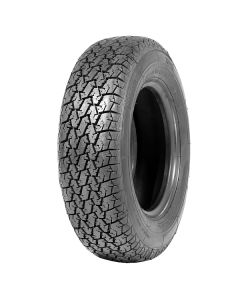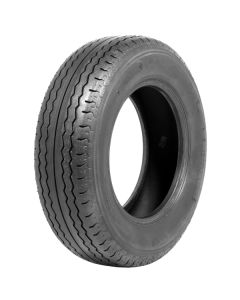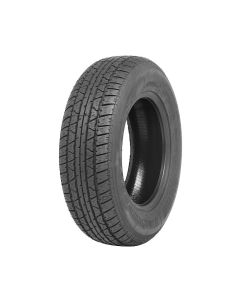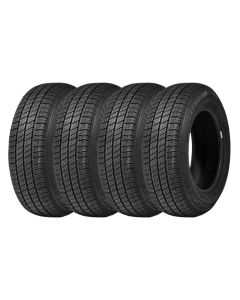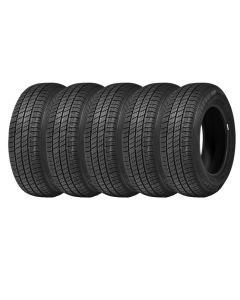Toyota Corolla Tyres
Toyota Corolla 1966–

- The Toyota Corolla 1500 fitted 5.60 - 13 tyres, the only tyre currently available in this size is the 5.60 x 13 Camac, however we recommend using the radial alternative 155 - 13.
- The tyre we recommend for this size would be the 155R13 PIRELLI CINTURATO CA67 or the 155 HR 13 Michelin XAS FF.
- Many other early Corollas fitted 155-13, the first of which was the first generation 1600 Sedan and Wagon. The Corolla 30 models all fitted 155 - 13 as well as the Corolla 1.3. From March 1980 onwards, the 1200 Liftback model and from 1975-1980 all other 1200 Corollas fitted a 13" wheel and thus was equipped with 155-13 tyres.
- The Low profile alternative of 155-13 is 175/70 - 13 and this was fit to the executive models of Corolla and the Corolla 1.6 GL fitted 175/70 - 13. We recommend the 175/70 VR 13 PIRELLI CINTURATO CN36. This was an extremely popular tyre at the time and you can see why. It has exceptional grip, even in the wet, leading to much more efficient braking.
- The Corolla 1100 and 1200 models pre 1980 (with the exception of the Liftback model) all fitted 155-12 tyres. The only tyre we currently have in this size is the 155 TR 12 Nankang.

- The Corolla 1600 Liftback fitted 165-13 up until 1980. It may also fit the low profile alternative 185/70 - 13, which was fitted by the 1.6 Liftback from 1980 onwards and the 4WD Corollas of the sixth generation onwards. The 1.6 GT / AE86 Corollas also fitted 185/70 - 13 or 195/60 14.
- The tyre we recommend for 165-13 is the 165R13 PIRELLI CINTURATO CN36. The XAS is a brilliant tyre made with a long-lasting road race compound that improves directional stability massively as well as remarkable road holding on bends.
- The recommended tyre for 185/70 R 13 is the 185/70 VR 13 PIRELLI CINTURATO CN36. Just like in the aforementioned size of CN36, the grip of this tyre is fantastic and it has an amazing steering response too. For this tyre we recommend the Michelin 13E.
- The GTi-16 and 1.6 GT Fi models of Corolla fitted 185/60 - 14. The tyre we recommend in this size is the 185/60 VR 14 Michelin Pilot Exalto PE2. Because this tyre is below 70 profile, you should not fit inner tubes into it.
Post-seventh-generation of Corolla (1995 onwards), 175/65 R 14 and 185/65 R 14 were fitted across the Corolla range, unfortunately, no classic tyre manufacturer currently makes a tyre in either of these sizes.
Toyota Corolla Innertubes
- We suggest that for 5.60 - 13, 155 - 13, 165 - 13, you should fit the Michelin 13D
- For 175/70 - 13 and 185/70 R 13 we suggest that you fit the Michelin 13E
- For 155-12 we suggest fitting a Michelin 12D.
- Our period Dunlop Innertube Guide informs which models transitioned to tubeless wheels, see below to find your year and model.
- For a more detailed view, check out our innertube fitment guide.
For the recommended tyre pressures for your model of Corolla, see our Corolla Tyre Pressure Guide below.
Toyota Corolla Pressure Guide
Toyota Corolla Generation Key
- Generation 1: 1966-1970
- Generation 2: 1970-1974
- Generation 3: 1974-1979
- Generation 4: 1979-1983
- Generation 5: 1983-1987
- Generation 6: 1987-1991
- Generation 7: 1991-1995
Generations refer to the lifecycle of a specific make and model.
| Model | Generation | Front (Psi) | Rear (Psi) |
|---|---|---|---|
| 1500 | 1 | 24 | 27 |
| 1200 Coupe | 3 | 26 | 30 |
| 1200 E | 3 | 26 | 30 |
| 1200 Estate | 3 | 24 | 28 |
| 1200 Liftback | 3 | 28 | 31 |
| 1600 Liftback | 3 | 27 | 32 |
| 30 Saloon and Coupe | 3 | 24 | 26 |
| 30 Estate | 3 | 24 | 28 |
| 1200 E | 4 | 26 | 30 |
| 1200 Saloon and Coupe | 4 | 26 | 30 |
| 1200 Estate | 4 | 28 | 32 |
| 1200 Liftback | 4 | 28 | 31 |
| 1600 Liftback | 4 | 27 | 32 |
| 30 Coupe and Saloon | 4 | 24 | 26 |
| 30 Estate | 4 | 24 | 28 |
| 1.3 GL | 5 | 30 | 30 |
| GT-i 16 (FWD) | 5 | 26 | 30 |
| 1.3 GL | 6 | 27 | 33 |
| 1.6 GL and Executive | 6 | 26 | 33 |
| 1.6 GT | 6 | 26 | 30 |
| GT-1.6 (FWD) | 6 | 26 | 30 |
| 1.3 Models | 7 | 27 | 33 |
| 4WD Models | 7 | 27 | 33 |
| Executive | 7 | 26 | 30 |
| GT-i 16 | 7 | 27 | 30 |
Is your model of Corolla not listed in our guide? Please give us a call on +44 0 1302 711 123, or email us at: info@longstonetyres.co.uk for information regarding tyre pressures for your Corolla, or if you have any other queries for us.
History of the Toyota Corolla
In the wake of the Publica's success in Japan in the mid-60s, the Corolla and its own success were heavily influenced by Japan's growing private car ownership and automobile trade after the rise of the "National Car".
The Corolla was launched in 1966 alongside the Datsun Sunny and the Subaru 1000, which were its major competition. Japan's taxation on-road vehicles were of large consideration towards the design of some of the other Japanese 60's cars, but Toyota on both the Corolla and Publica chose to make a more powerful car at the expense of being placed into a higher tax class. Whilst the Datsun 1000 was a 988cc engine the Corolla was a 1077cc engine, this was pushed heavily in advertising, saying it had a "100cc advantage" over the Datsun 1000, which was a bit cheeky of them considering they were only 89cc higher. in 1969 the 1.1L 1077 engine was upgraded to a 1.2L 1166 cc engine, and a twin carburettor version was installed in the SL and Sprinter variations.
The second generation of Corolla was launched in May of 1970. The front suspension design was improved greatly, implementing a swaybar. The rear remained pretty much the same with no significant changes. In 1970, the Corolla became the second-best-selling car in the world, displaying just how popular the car would become in the following years. Two facelifts were made in this generation, one in 1971 and one in 72, both only added minor trim changes and lighting improvements. This generation also saw the introduction of the Levin model of Corolla and near-identical twin, the Sprinter Trueno.

The third generation of Corolla came about in August 1974, this year was key to the Corolla's export growth as, during the fuel crisis, Toyota had their greatest growth in the states in this generation. Despite criticisms from various motor enthusiast publications, saying that it didn't size up to the smaller and more economic Honda Civic or VW Rabbit, public opinion wasn't swayed as they were still very popular internationally.
1979 started the fourth generation of Corolla which brought a major redesign to the trim, shifting to a much squarer design than before. The design was made by Fumio Agetsuma and his team. Agetsuma stated that the new Corolla needed to be efficient, suitable for all consumers in all countries and conditions, and they needed to advance the Corolla but keep the core values surrounding the car. The resulting production of Corollas was just that, they developed upon the base of what made the Corolla such a brilliant car and because of this, the one-millionth Corolla was built in 1983, with a commemorative version being made briefly in Japan.
The 5th generation hit the market in 1983. Most models were now front-wheel drive at this point aside from the Corolla Levin / Sprinter Trueno, 3-door liftback and van, and the 5-door wagon versions of the fourth generation which remained in production. The Corolla of this generation featured a sloping bonnet and an optional fuel injection installation from dealerships internationally. In a joint venture with General Motors, rebadged sprinters of this generation were sold in the U.S as the Chevrolet Nova, the only differentiation between the Sprinter/Nova and the Corolla were pop-up headlights and other minor trim changes
The Sixth Generation was released in 1987, featuring all-wheel-drive models alongside a now non-RWD generation of Corollas. This generation featured a variety of export model names. In South Africa, the Toyota Carri, Conquest, and Tazz were marketed. In another joint venture with General Motors, the Geo Prizm / Chevrolet Prizm was sold in the States. In Australia the UAAI was formed as an alliance between Toyota and Holden in 1989, the same year the Holden Nova was released as a rebadged Corolla. Eventually, the Holden Nova received some differentiating trim changes, however, this wouldn't stop the Corolla from outselling it in every year it was produced.

The Seventh generation lasted from 1991-1995, this generation had a larger wheelbase and a more rounded and aerodynamic design than the prior squarer Corollas. The Corolla Ceres and Sprinter Marino were released in this generation. They didn't look much like Corollas but had the engine and chassis of the standard Corollas of the generation and the dashboard of the Levin/Trueno.
The Toyota Corolla over its (as of 2021) 12 generations is the biggest selling nameplate of any car. This should come as no surprise really as, throughout the years, the Corolla has proved to be a timeless, reliable design that was almost all-purpose, especially with the Levin/Trueno variations proving that the Corolla didn't have to be just a bog-standard A to B family saloon as it was designed, Corollas can also be cool race-worthy cars! Due to the sheer availability of these cars and their parts, plenty of people have taken to making brilliant off-roaders and rally variations, Toyota included as they won the WRC manufacturers title and four rally victories with a Corolla in 1999. This Corolla (Toyota Corolla WRC) featured the Celica's 3S-GTE inline-4 engine with a water-cooled turbo system and a 4WD system from the Celica GT-Four, this car was raced for the Toyota factory team by Carlos Sainz and Didier Auriol with co-drivers, Luis Moya and Denis Giraudet.
Innertube Guides




















